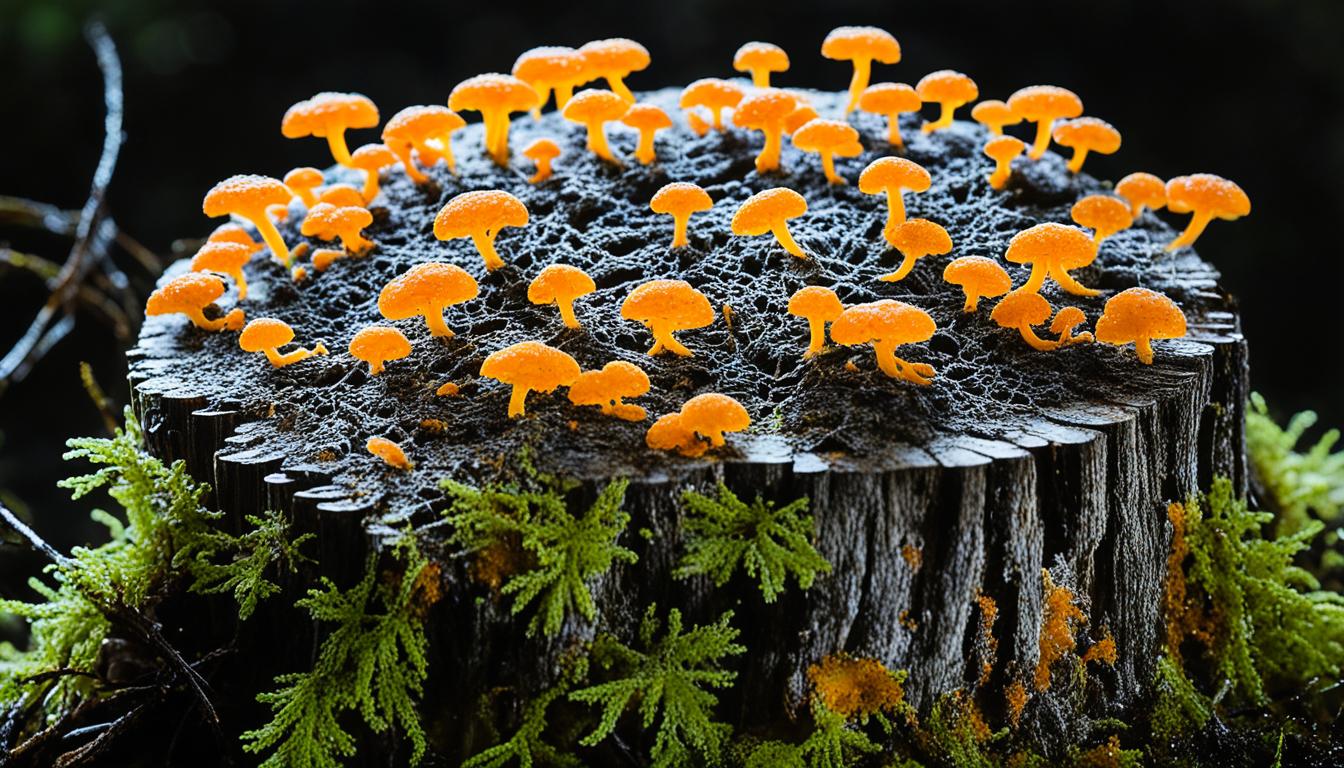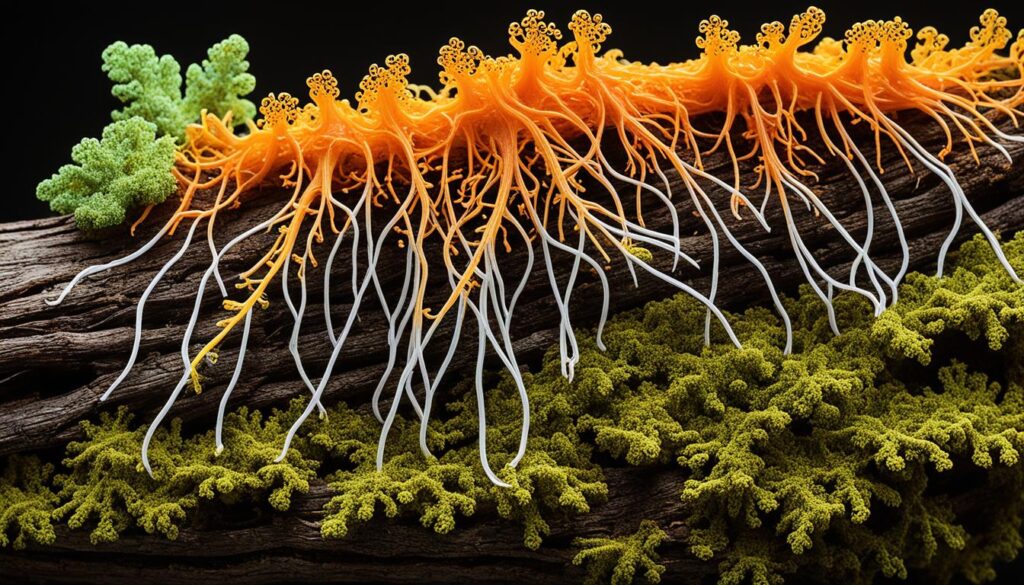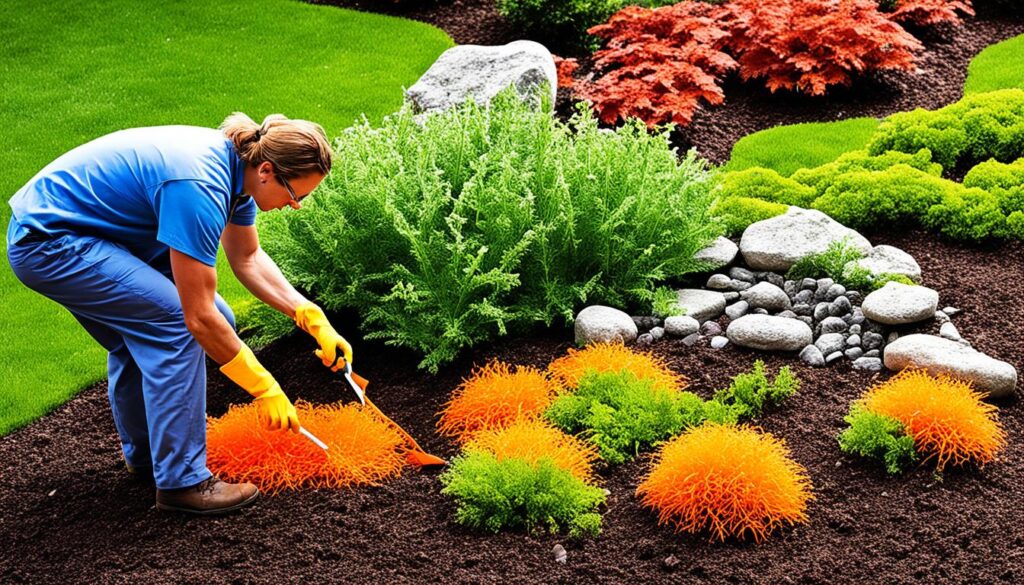
Innovative Techniques for orange slime Mold
Orange slime mold can be a persistent issue for gardeners and professionals alike. Its unsightly appearance and rapid spread can quickly disrupt the beauty and functionality of outdoor spaces. Fortunately, there are innovative techniques and strategies that can effectively manage this common problem.
By staying informed and utilizing sustainable solutions, you can combat orange slime mold and maintain a healthy environment for your plants and landscape. In this article, we will explore the characteristics of orange slime mold, its lifecycle, and the causes of its growth. Armed with this knowledge, we will then introduce innovative techniques for prevention and remediation.
Key Takeaways:
- Orange slime mold can be effectively managed with the right techniques and strategies.
- Understanding the characteristics and causes of orange slime mold is essential for successful management.
- Implementing sustainable prevention methods is key to preventing the growth and spread of orange slime mold.
- Remediation methods should also focus on sustainable approaches that minimize environmental impact.
- By combining knowledge, prevention, and effective techniques, you can successfully manage orange slime mold in your garden or professional environment.
Understanding Orange Slime Mold
Before delving into the techniques for managing orange slime mold, it is important to have a clear understanding of what it is. In this section, we will discuss the characteristics, lifecycle, and causes of orange slime mold. Gain insight into how this organism thrives and spreads, which will provide a foundation for effective management strategies.
Characteristics of Orange Slime Mold
Orange slime mold, scientifically known as Fuligo septica, is a fascinating organism that belongs to the group of Myxomycetes. It is commonly referred to as “dog vomit slime mold” due to its appearance, which resembles dog vomit or bright orange foam. This mold typically grows in damp environments with decaying organic matter, such as mulch, dead leaves, or logs.
Lifecycle of Orange Slime Mold
The lifecycle of orange slime mold consists of several distinct stages. Initially, it exists as spores dispersed in the air or carried by insects and animals. When conditions are favorable, the spores germinate and develop into plasmodia, a gelatinous mass that can move and engulf organic substances. As the plasmodium matures, it transforms into a fruiting body that releases spores, allowing the mold to reproduce and start the cycle again.
“The lifecycle of orange slime mold is a fascinating process, where it transitions through different stages to ensure its survival and reproduction.”
Causes of Orange Slime Mold
Orange slime mold thrives in humid environments and is often triggered by excessive moisture, high temperatures, and nutrient-rich substrates. It can develop in various outdoor locations, including gardens, woodlands, and even on decaying wood structures. Poor drainage, overwatering, organic debris accumulation, and lack of sunlight can contribute to the growth of orange slime mold.
“Understanding the causes of orange slime mold is crucial for implementing effective prevention and management strategies.”

Orange Slime Mold Characteristics
| Characteristics | Description |
|---|---|
| Appearance | Bright orange, foam-like texture |
| Habitat | Damp environments with decaying organic matter |
| Lifecycle | Spore germination, plasmodium development, formation of fruiting body |
| Causes | Excessive moisture, high temperatures, nutrient-rich substrates |
Sustainable Prevention and Remediation Methods
Prevention and remediation play crucial roles in effectively managing orange slime mold. To ensure a sustainable approach, it’s important to explore methods that prevent the growth and spread of this common issue in gardens and other environments. By implementing environmentally friendly strategies, you can mitigate the presence of orange slime mold and maintain a healthy space.
Prevention Methods
To prevent orange slime mold, it’s essential to address the underlying causes that contribute to its growth. Here are some sustainable prevention techniques:
- Improve drainage: Orange slime mold thrives in moist conditions, so ensuring good drainage in your garden is a crucial step. This can be achieved by amending the soil with organic matter, such as compost, to enhance its water-holding capacity.
- Avoid overwatering: Maintaining proper watering practices is essential. Overwatering can create excessive moisture, providing an ideal environment for orange slime mold to develop. Water your plants according to their specific needs and monitor soil moisture regularly.
- Promote air circulation: Orange slime mold tends to grow in areas with poor air circulation. Prune and thin out dense vegetation to improve airflow and reduce humidity levels.
- Remove organic debris: Clear away fallen leaves, dead plants, and other organic materials regularly. These decomposing matter can harbor spores and provide nutrients for orange slime mold to thrive.
Remediation Methods
If orange slime mold has already appeared in your garden, prompt action is necessary to prevent further spread. Here are some sustainable remediation methods:
- Manual removal: Carefully remove the slime mold using a gloved hand or a trowel. Place the affected material in a sealed bag and dispose of it properly to prevent cross-contamination.
- Improve sunlight exposure: Orange slime mold prefers shady and damp areas. Increasing sunlight exposure to affected areas can help dry out the environment and inhibit its growth.
- Apply vinegar solution: Mix equal parts vinegar and water in a spray bottle. Directly spray the solution onto the affected area to discourage the growth of orange slime mold.
- Consider biological controls: Introducing beneficial organisms, such as predatory mites or nematodes, can help control the population of orange slime mold by feeding on it.
- Regular maintenance: Maintain a clean and well-maintained garden to minimize conditions favorable for orange slime mold growth. Regularly monitor for signs of infestation and take immediate action if detected.

By incorporating these sustainable prevention and remediation methods into your gardening practices, you can effectively manage orange slime mold while minimizing the use of harsh chemicals and promoting a healthier environment for your plants.
Conclusion
In conclusion, effectively managing orange slime mold requires a combination of innovative techniques, prevention strategies, and sustainable remediation methods. By understanding the nature of this organism and implementing effective measures, gardeners and professionals can successfully tackle this common issue.
Prevention plays a crucial role in controlling the growth and spread of orange slime mold. By maintaining proper hygiene and cleanliness in garden environments, such as regular removal of decaying organic matter and adequate ventilation, the conditions that favor orange slime mold can be minimized.
Additionally, sustainable remediation methods can be employed to address existing outbreaks. This may include physically removing the slime mold, using natural fungicides, or introducing beneficial organisms that compete with it. It’s important to choose environmentally friendly solutions that do not harm other beneficial organisms in the ecosystem.
For expert assistance with mold assessment, prevention, and remediation, contact Fix Mold Miami at 305-465-6653. Our team of professionals specializes in managing mold-related issues and can provide tailored solutions to effectively eradicate orange slime mold and ensure a healthy environment for your garden.




